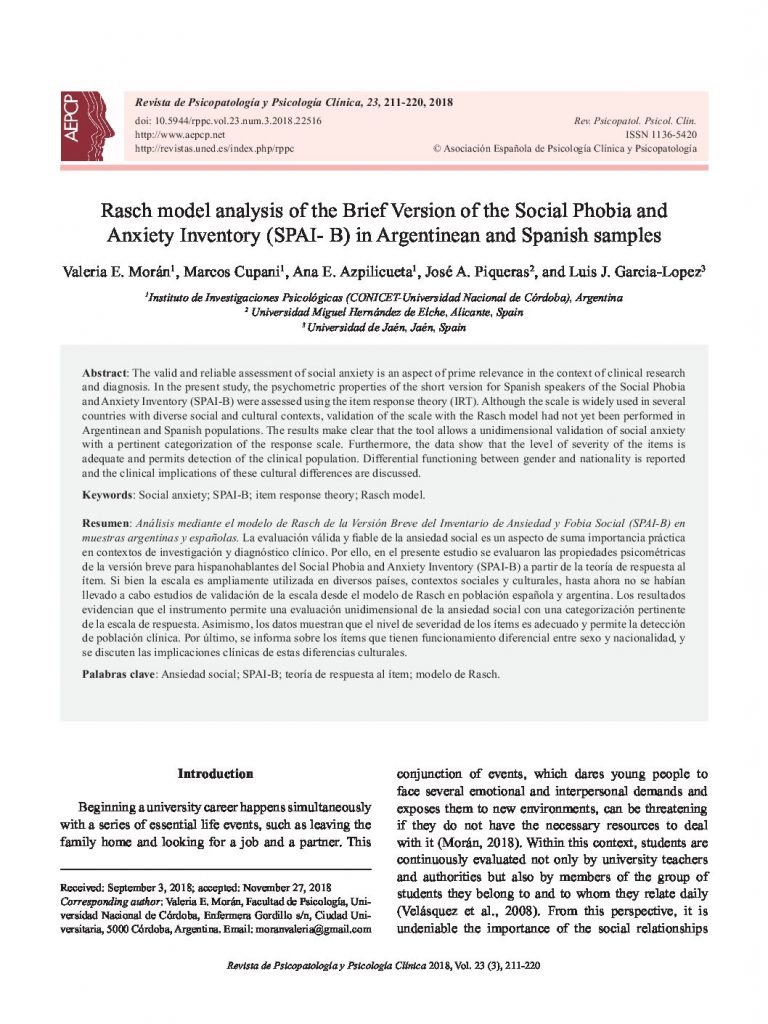Rasch model analysis of the Brief Version of the Social Phobia and Anxiety Inventory (SPAI- B) in Argentinean and Spanish samples.

- Escala de Síntomas de los Trastornos de Ansiedad y Depresión (ESTAD): Datos preliminares sobre su estructura factorial y sus propiedades psicométricas.
- Temperament and attachment as predictive factors for the risk of addiction to substances in adolescents.
- Conducta autolesiva no suicida en adolescentes y su relación con factores personales y contextuales.
- Efectividad y aceptabilidad del entrenamiento en habilidades de la terapia dialéctica comportamental para familiares de personas con trastorno de personalidad límite.
- Rasch model analysis of the Brief Version of the Social Phobia and Anxiety Inventory (SPAI- B) in Argentinean and Spanish samples.
- Información sobre los indicadores métricos de la Revista de Psicopatología y Psicología Clínica.
- Variables de riesgo y protección relacionadas con la tentativa de suicidio.
- Adaptación del Cuestionario para Identificación de Trastornos Debidos al Consumo de Alcohol (AUDIT) en universitarios colombianos.
A valid and reliable assessment of social anxiety is a subject of practical relevance in the field of clinical research and diagnosis. In the present study, psychometric properties of the Spanish version of the Social Phobia and Anxiety Inventory (SPAI-B) using the item response theory (IRT) were assessed. Although the inventory is widely used in several countries and cultural contexts, validation studies of the scale had not been performed yet from the Rasch model perspective in Argentinean and Spanish populations. The results indicate that the tool allows a unidimensional assessment of social anxiety with a pertinent categorization of the response scale. Furthermore, the data show that the level of severity of the items is adequate and allows the detection of clinical population. It was reported on the items with a differential functioning between gender and nationality, and the clinical implications of such differences were discussed.
La evaluación válida y fiable de la ansiedad social es un aspecto de suma importancia práctica en contextos de investigación y diagnóstico clínico. Por ello, en el presente estudio se evaluaron las propiedades psicométricas de la versión breve para hispanohablantes del Social Phobia and Anxiety Inventory (SPAI-B) a partir de la teoría de respuesta al ítem. Si bien la escala es ampliamente utilizada en diversos países, contextos sociales y culturales, hasta ahora no se habían llevado a cabo estudios de validación de la escala desde el modelo de Rasch en población española y argentina. Los resultados evidencian que el instrumento permite una evaluación unidimensional de la ansiedad social con una categorización pertinente de la escala de respuesta. Asimismo, los datos muestran que el nivel de severidad de los ítems es adecuado y permite la detección de población clínica. Por último, se informa sobre los ítems que tienen funcionamiento diferencial entre sexo y nacionalidad, y se discuten las implicaciones clínicas de estas diferencias culturales.



